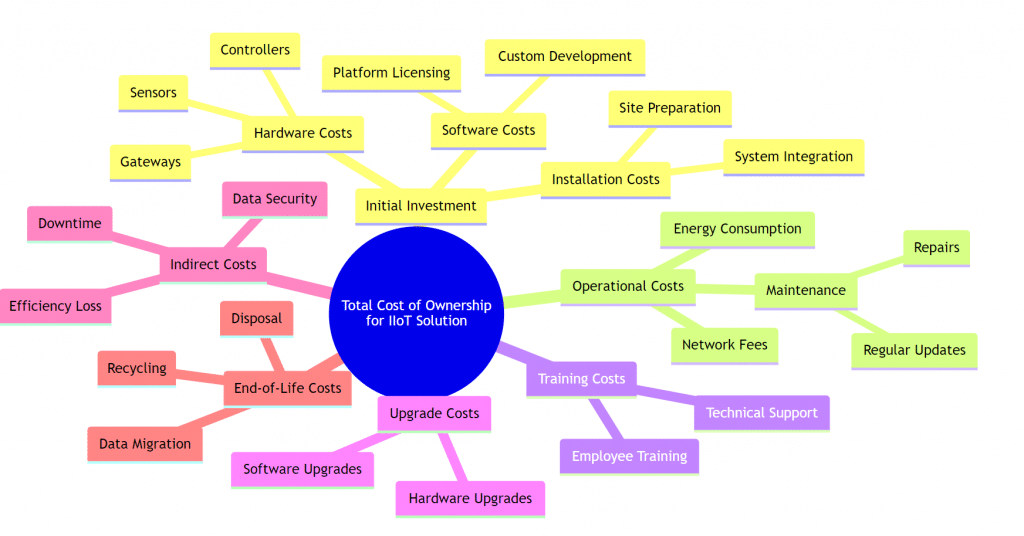Deploying an Industrial IoT solution isn’t just about technology, it’s also about understanding the full financial costs of deploying such a solution. Let’s break down the Total Cost of Ownership (TCO) for an IIoT solution.

Initial investment
This includes hardware costs like sensors and controllers.
For instance, a manufacturing plant might invest in temperature sensors and programmable logic controllers (PLCs) to automate their assembly line. Software costs are also part of this phase, covering expenses for platform licenses and any bespoke software development. A good example is a logistics company paying for a custom IIoT platform to track fleet movements. Installation costs, such as setting up the network and integrating systems, are also crucial. Think of a warehouse integrating IIoT devices with their existing inventory management system.
Operational Costs
Once operational, the IIoT system incurs ongoing costs.
Maintenance is key here, involving routine updates and repairs. For example, an energy company might regularly update the firmware of their smart meters. Energy consumption is another factor, like the electricity used by sensors in a smart building. Network fees, essential for cloud connectivity and data sharing, are also ongoing. A retail chain, for instance, might pay monthly fees for cloud-based data storage of customer footfall data captured by IIoT sensors.
Training Costs
Training is vital for any tech deployment.
Employees need to learn how to use the new IIoT system effectively. A car manufacturer, for example, might train their staff on using a new IIoT-based quality control system. Technical support, both in-house and external, is also part of this cost. Consider a hospital training its maintenance team to troubleshoot their IIoT-enabled medical devices.
Upgrade Costs
To stay relevant and secure, IIoT systems need upgrades.
Hardware upgrades might involve a factory replacing old sensors with newer, more efficient models. Software upgrades are also critical, like a utility company updating its IIoT platform for better cybersecurity.
Indirect Costs
Indirect costs can sneak up.
Downtime costs, for example, occur when an IIoT system goes offline, impacting operations. Imagine an e-commerce warehouse’s conveyor belt sensors failing, slowing down package sorting. Efficiency loss, like reduced production speed due to outdated IIoT tech, is another hidden cost. Data security is also crucial; a data breach in an IIoT-enabled smart city infrastructure could have significant financial implications.
End-of-Life Costs
Eventually, IIoT solutions will need phasing out or replacement.
Disposal and recycling of old hardware, like a telecom company responsibly disposing of outdated routers, are part of these costs. Data migration, such as transferring data from an old IIoT system to a new one in a smart factory, also incurs expenses.
Conclusion
Grasping the TCO of an IIoT solution is more than just stacking up bills—it’s about understanding the lifecycle of the technology in a real-world context. From the initial setup to eventual upgrades and replacement, each phase has its own costs and considerations, all integral to making the most of IIoT’s transformative potential.
